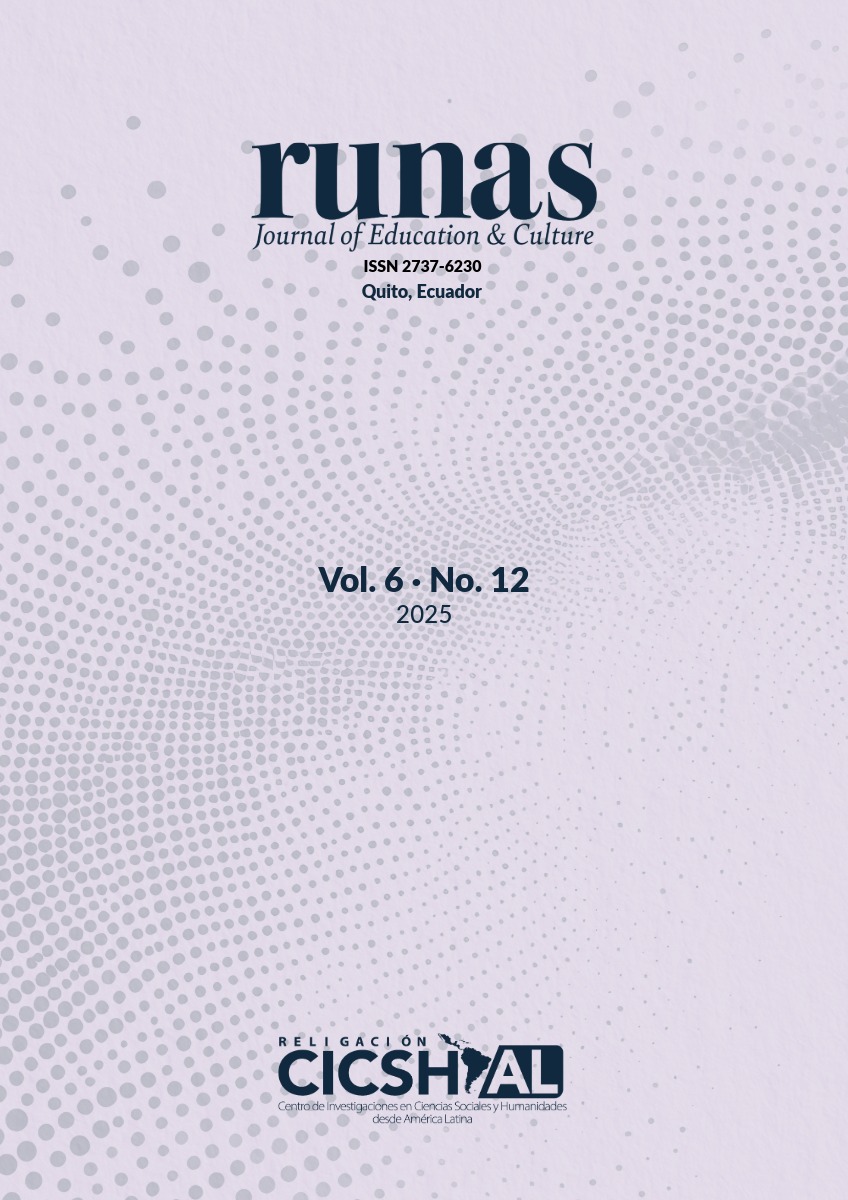Resumen
Esta revisión bibliográfica se realizó mediante una metodología sistemática para investigar el papel de los principios neuropedagógicos en la mejora de la adquisición de una segunda lengua en estudiantes de primaria. También se analizaron las características cognitivas y emocionales de los enfoques neuropedagógicos en el desarrollo infantil temprano y las percepciones del profesorado. Mediante el uso de palabras clave, operadores booleanos y criterios de exclusión, se seleccionaron 17 artículos científicos para su análisis. Se identificaron cuatro estrategias neuropedagógicas para fomentar el aprendizaje del inglés como lengua extranjera en niños: aprendizaje multisensorial, recursos tecnológicos y multimedia, Respuesta Física Total (RFT) y Aprendizaje Basado en Proyectos (ABP). Se concluyó que las estrategias neuropedagógicas incentivan el aprendizaje del inglés al fomentar la participación activa en clase y hacer que la adquisición de vocabulario sea amena. Asimismo, fueron eficaces para promover la plasticidad cerebral y la adaptabilidad al adquirir nuevos conocimientos.
Citas
Abdi, A., & Canvus, N. (2019). Developing Electronic Device to Teach English as a Foreign Language: Educational Toy for Pre-Kindergarten Children. International Journal of Emerging Technology in Learning, Kassel, Germany, 14(22). https://doi.org/10.3991/ijet.v14i22.11747
Aisyah, S., & Novita, D. (2025). Teachers’ perception of the implementation of project-based learning in early childhood education in Indonesia. Congent Education, 12(1), 1-17. https://doi.org/10.1080/2331186X.2025.2458663
Barabanova, I., & Kazlauskiene, A. (2020). Neuropedagogy: preconditions for application of neuroscience results in the education process while providing feedback /. Techniumscience, 2, 112-122.
Chojak, M. (2018). Neuropedagogy as a Scientific Discipline: Interdisciplinary Description of the Theoretical Basis for the Development of a Research Field. International Journal of Educational and Pedagogical Sciences, 12(8), 1-4. https://doi.org/10.5281/zenodo.1474341
Co?ar, Z., & Orhan, R. (2019). Teaching Kindergarten Children English Vocabulary by Total Physical Response in Physical Education Courses. Journal of Physical Education and Sports Management, 6(2), 70-76. https://doi.org/10.15640/jpesm.v6n2a8
Davronbek, Y. (2023). System of Principles of Neuropedagogy. The European Journal of Education, (4), 126. https://doi.org/10.29013/EJEAP-23-4-126-129
Freire, R., León, M., Espin, L., & Maldonado, G. (2025). Teaching-learning strategies of English as a second language using aesthetic expressions. Pontificia Universidad Católica del Ecuador, Quito, Ecuador, 1(2), 1821-1839. https://doi.org/10.23857/pc.v10i2.9003
González, F., Cascales, A., & Gomariz, M. (2022). Neurodidactic strategies in the area of English Language in kindergarten and elementary education. Multidisciplinary Journal of Education, 15(31), 43-56.
Hernández, A. (2022). Neuropedagogy and neuroimaging. exto Livre, 15. https://doi.org/10.35699/1983-3652.2022.40453
Hossain, R., & Flint, S. (2015). The Effectiveness of Using Technology in English Language Classrooms in Government Primary Schools in Bangladesh. FIRE: Forum for International Research in Education, 2(5), 47-59.
Kamenická, J. (2022). Brain-Based TEFL. Faculty of Education of Constantine the Philosopher University.
Khairma, F., & Suryana, D. (2019). Implementation of TPR (Total Physical Response) Method in Learning English in Barunawati Kindergarten. Advances in Social Science, Education and Humanities Research, 337, 257-260. https://doi.org/10.2991/picema-18.2019.53
Kimsesiz, F., Dolgunsoz, E., & Konca, Y. (2017). The Effect of Project Based Learning in Teaching EFL Vocabulary to Young Learners of English: The Case of Pre-school Children. International Journal of Languages’ Education and Teaching, 5(4), 426-439.
López, J., & Villafuerte, J. (2021). Educational innovation into English as a Foreign Language Practices for Early Children: Neuroeducation and the Total Physical Response Method. The Asian Institute of Research, 4(3), 377-389. http://dx.doi.org/10.31014/aior.1993.04.03.346
Luna, K., Chicaiza, R., Heredia, E., & Schettini, T. (2024). Innovation in the Teaching-Learning Process of the English Language in Basic General Education. Revista Científica Arbitrada Multidisciplinaria PENTACIENCIAS, 6(4), 66-76. https://doi.org/10.59169/pentaciencias.v6i4.1127
Matos, J., Piedade , J., Freitas, A., Pedro, N., Dorotea , N., Pedro , A., & Galego, C. (2023). Teaching and Learning Research Methodologies in Education:A Systematic Literature Review. Educ. Sci., 13(2), 1-23. https://doi.org/10.3390/educsci13020173
Medvedieva, S., Stepanova, I., Nykyporets, S., & Ibrahimova, L. (2023). The application of a neuropedagogical approach while teaching English to students of higher educational establishments. Prospects and innovations of science, 26(8). http://dx.doi.org/10.52058/2786-4952-2023-8(26)-13-24
Mendieta, D., & Reyes, O. (2022). Methodological Strategies for the Development of Language Skills in Elementary School Children. InternationalJournal of Linguistics, Literatureand Culture, 8(4), 210-217. https://doi.org/10.21744/ijllc.v8n4.2146
Montessori, M. (1966). The secret of childhood. Ballantine Books.
Putri, M., Sudarti, S., & Zar’in, F. (2024). Implementation of Project-Based Learning Method in Developing Cognitive Abilities of Children Aged 5-6 Years Through Loose Parts Media. Journal of Education and Teaching Learning (JETL), 6(1), 106-117. http://dx.doi.org/10.51178/jetl.v6i1.1793
Quevedo, S., & Huamani, L. (2024). English teaching and learning strategies used in early childhood education students. Revista Interdisciplinaria de Humanidades, Educación, Ciencia y Tecnología, X(18), 184-198.
Raihan, M., & Hua, K. (2020). Multisensory Learning Approach: Impacts on Phonological Awareness among Young ESL Learners in a Rural Setting. Universal Journal of Educational Research, 8(12), 6692-6705. http://dx.doi.org/10.13189/ujer.2020.081234
Rustan, N., Cahyono, B., & Junaid, R. (2023). Teachers’ perspectives on technology-based learning for the kindergarten students. Journal of Education and Learning (EduLearn), 17(3), 374-381.
Sousa, D. A. (2011). How the brain learns. Corwin Press.
Sumihatul, S. (2017). The Implementation of TPR (Total Physical Response) Method in Teaching English for Early Childhood. Advances in Social Science, Education and Humanities Research (ASSEHR), 58, 421-427. https://doi.org/10.2991/icece-16.2017.74
Vovk, O., Zenya, L., & Brovarska, I. (2022). Neuropedagogy: A concept of brain compatible teaching a foreign language. Bulletin of Bohdan Khmelnytsky National University of Cherkasy, (2), 1-10. https://doi.org/10.31651/2524-2660-2022-2-64-73
Yunita, W., Zaim, M., Syarif, H., & Zainil, Y. (2022). The Effectiveness of Project-Based Learning through Vlog to Improve Pre-Schoolers’ Vocabulary Mastery. Journal Pendidikan Anak Usia Dini, 6(5), 4661-4668. https://doi.org/10.31004/obsesi.v6i5.2232

Esta obra está bajo una licencia internacional Creative Commons Atribución-NoComercial-SinDerivadas 4.0.
Derechos de autor 2025 Paola Gabriela Heredia Muñoz, Melita Vega





